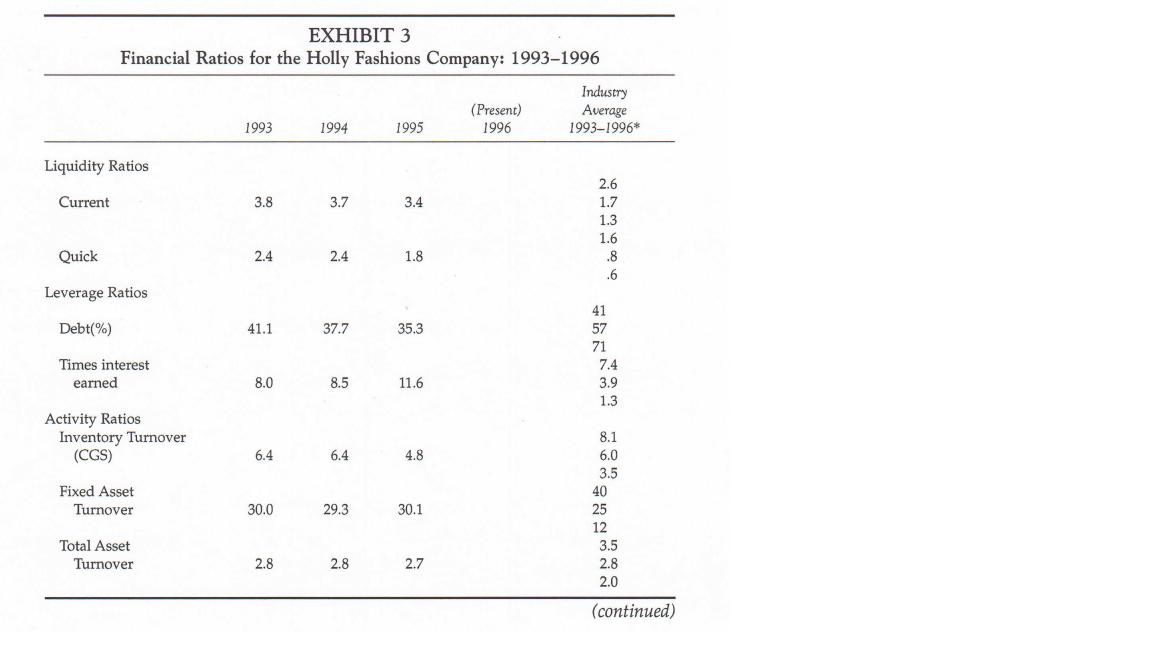Answered step by step
Verified Expert Solution
Question
1 Approved Answer
1. Calculate the firm's 1996 ratios listed in Exhibit 3. 2. Part of Hamilton's evaluation will consist of comparing the firm's ratios to the






1. Calculate the firm's 1996 ratios listed in Exhibit 3. 2. Part of Hamilton's evaluation will consist of comparing the firm's ratios to the industry numbers shown in Exhibit 3. (a) Discuss the limitations of such a comparative financial analysis. (b) In view of these limitations, why are such industry comparisons so frequently made? 3. Hamilton thinks that the profitability of the firm to the owners has been hurt by White's reluctance to use much interest-bearing debt. Is this a reasonable position? Explain. 4. The case mentions that White rarely takes trade discounts, which are typically 1/10, net 30. Does this seem like a wise financial move? Explain. 5. Calculate the company's market-to-book (MV/BV) ratio. (There are 5,000 shares of common stock.) 6. Hamilton's position is that White has not competently managed the firm. Defend this position using your previous answers and other information in the case. 38 PART II FINANCIAL ANALYSIS 7. White's position is that he has effectively managed the firm. Defend this position using your previous answers and other information in the case. 8. Play the role of an arbitrator. Is it possible based on an examination of the firm's ratios and other information in the case to assess White's managerial competence? Defend your position. 9. (a) Are the ratios you calculated based on market or book values? Explain. (b) Would you prefer ratios based on market or book values? Explain. Sales Cost of goods Gross margin Administrative Depreciation EBIT Interest EBT Taxes Net income EXHIBIT 1 Holly Fashions' Income Statements: 1993-1996 (000s) 1993 1995 $985.0 748.6 236.4 169.4 10.8 56.1 7.0 49.1 19.7 $29.5 1994 $1,040.0 774.8 265.2 202.8 11.4 51.0 6.0 45.0 18.0 $27.0 $1,236.0 928.2 307.8 236.1 13.6 58.1 5.0 53.1 21.2 $31.9 1996 $1,305.0 978.8 326.3 249.3 14.4 62.6 4.0 58.6 23.5 $35.2 ASSETS Cash EXHIBIT 2 Balance Sheets of the Holly Fashions Company: 1993-1996 (000s) 1993 Receivables Inventory Other current Current assets Gross fixed $40.4 153.2 117.0 5.9 316.5 44.8 Accumulated depreciation (12.0) Net fixed 32.8 Total assets $349.3 1994 $51.9 158.9 121.1 6.2 338.0 58.9 (23.4) 35.5 $373.5 1995 $38.6 175.1 193.4 7.4 414.5 78.1 (37.0) 41.1 $455.5 1996 $10.6 224.8 191.9 7.8 435.1 96.4 (51.4) 45.0 $480.1 (continued) LIABILITIES & NET WORTH Accounts payable Debt due Accruals Current liabilities Long-term debt Common stock Retained earnings Total L&NW EXHIBIT 2 (Continued) 1993 $53.8 10.0 19.7 83.5 60.0 150.0 55.8 $349.3 CASE 6 HOLLY FASHIONS 1994 $54.7 10.0 26.0 90.7 50.0 150.0 82.8 $373.5 1995 $86.2 10.0 24.7 120.9 40.0 180.0 114.6 $455.5 1996 $84.2 10.0 26.1 120.3 30.0 180.0 149.8 $480.1 39 EXHIBIT 3 Financial Ratios for the Holly Fashions Company: 1993-1996 Liquidity Ratios Current Quick Leverage Ratios Debt(%) Times interest earned Activity Ratios Inventory Turnover (CGS) Fixed Asset Turnover Total Asset Turnover 1993 3.8 2.4 41.1 8.0 6.4 30.0 2.8 1994 3.7 2.4 37.7 8.5 6.4 29.3 2.8 1995 3.4 1.8 35.3 11.6 4.8 30.1 2.7 (Present) 1996 Industry Average 1993-1996* 2.6 1.7 1.3 1.6 .8 .6 41 57 71 7.4 3.9 1.3. 8.1 6.0 3.5 40 25 12 3.5 2.8 2.0 (continued) 40 PART II FINANCIAL ANALYSIS Average Collection Period Days Purchases Outstanding** Profitability Ratios Gross Margin (%) Net Profit Margin (%) Return on Equity (%) Return on Total Assets (%) Operating Margin*** (%) 1993 56 25 24.0 3.0 14.3 8.4 6.8 EXHIBIT 3 (Continued) 1994 55 22 25.5 2.6 11.6 7.2 6.0 1995 51 31 24.9 2.6 10.8 7.0 6.1 (Present) 1996 Industry Average 1993-1996* 41 50 68 18 25 32 28 26 24 4.2 3.1 1.2 27.3 19.5 7.8 11.8. 8.7 3.4 9.9 7.2 3.1 *The three numbers for each ratio are computed in the following way. Ratios for all firms in the industry are arranged in what is considered a strongest-to-weakest order. The middle number represents the median ratio; that is, half the firms in the industry had ratios better than the median ratio and half had ratios that were worse. The top number represents the upper quartile figure, meaning 25 percent of the firms had ratios better than this. The lower number represents the lowest quartile, that is, 25 percent of the firms had ratios worse than this. **This shows the average length of time that trade debt is outstanding. Also called the average payment period. Calculated as A/P + (CGS/360). ***Calculated as (EBIT + Dep)/Sales.
Step by Step Solution
★★★★★
3.48 Rating (151 Votes )
There are 3 Steps involved in it
Step: 1

Get Instant Access to Expert-Tailored Solutions
See step-by-step solutions with expert insights and AI powered tools for academic success
Step: 2

Step: 3

Ace Your Homework with AI
Get the answers you need in no time with our AI-driven, step-by-step assistance
Get Started


